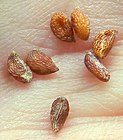Note: This is a project under development. The articles on this wiki are just being initiated and broadly incomplete. You can Help creating new pages.
Ananas comosus
Ananas comosus is native to South America and is currently cultivated in most tropical countries. Some of insect pests of pineapple worldwide are the pink pineapple mealybug, the gray pineapple mealybug, and the fruit borer caterpillar.
Contents
[hide]- 1 Uses
- 2 Parts Used
- 3 Chemical Composition
- 4 Common names
- 5 Properties
- 6 Habit
- 7 Identification
- 8 List of Ayurvedic medicine in which the herb is used
- 9 Where to get the saplings
- 10 Mode of Propagation
- 11 How to plant/cultivate
- 12 Commonly seen growing in areas
- 13 Photo Gallery
- 14 References
- 15 External Links
Uses
Sore throats, Relieves dyspepsia, Constipation, Fractures, Burns, Itches, Boils, Dysentery, Indigestion[1].
Parts Used
Fruits, Terminal buds, Flowering stem, Young shoots[1].
Chemical Composition
he chemical constituents from the air-dried leaves of A. comosus were isolated and purified by the chromatography on silica gel and Sephadex LH-20 columns as well as recrystallization.[2]
Common names
| Language | Common name |
|---|---|
| Kannada | Aananas Hannu, Ananasu |
| Hindi | Ananas |
| Malayalam | |
| Tamil | Aanahi phalam |
| Telugu | Ananas Pundu |
| Marathi | |
| Gujarathi | |
| Punjabi | |
| Kashmiri | |
| Sanskrit | Anarush |
| English | Fineapple |
[1].
Properties
Reference: Dravya - Substance, Rasa - Taste, Guna - Qualities, Veerya - Potency, Vipaka - Post-digesion effect, Karma - Pharmacological activity, Prabhava - Therepeutics.[3]
Dravya
Rasa
Madhura (Sweet), Amla (Sour)
Guna
Guru (Heavy for Digestion), Snigdha (Slimy in Nature)
Veerya
Sheeta (Cold)
Vipaka
Madhura (Undergoes sweet taste after digestion)
Karma
Vatapitta Shamaka (Reduces Vitiated vata and Pitta Dosha)
Prabhava
Habit
Identification
Leaf
| Kind | Shape | Feature |
|---|---|---|
| Flowering season is July to August |
Flower
| Type | Size | Color and composition | Stamen | More information |
|---|---|---|---|---|
| {{{5}}} |
Fruit
| Type | Size | Mass | Appearance | Seeds | More information |
|---|---|---|---|---|---|
| Fruiting season is July to August |
Other features
List of Ayurvedic medicine in which the herb is used
Where to get the saplings
Mode of Propagation
How to plant/cultivate
A plant of the moist, mainly lowland tropics, where it can also be found at elevations up to 1,800 metres.[5]
Commonly seen growing in areas
Photo Gallery
References
External Links
- Ayurvedic Herbs known to be helpful to treat Sore throats
- Ayurvedic Herbs known to be helpful to treat Relieves dyspepsia
- Ayurvedic Herbs known to be helpful to treat Constipation
- Ayurvedic Herbs known to be helpful to treat Fractures
- Ayurvedic Herbs known to be helpful to treat Burns
- Ayurvedic Herbs known to be helpful to treat Itches
- Ayurvedic Herbs known to be helpful to treat Boils
- Ayurvedic Herbs known to be helpful to treat Dysentery
- Ayurvedic Herbs known to be helpful to treat Indigestion
- Herbs with Fruits used in medicine
- Herbs with Terminal buds used in medicine
- Herbs with Flowering stem used in medicine
- Herbs with Young shoots used in medicine
- Herbs with common name in Kannada
- Herbs with common name in Hindi
- Herbs with common name in Tamil
- Herbs with common name in Telugu
- Herbs with common name in Sanskrit
- Herbs with common name in English
- Habit - Perennial
- Index of Plants which can be propagated by Stem cuttings
- Index of Plants which can be propagated by Seeds
- Herbs that are commonly seen in the region of Savannahs
- Herbs
- Pages without herbs images





